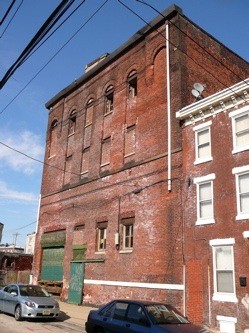1224-1228 Frankford Avenue, Philadelphia PA 19125
© Stuart Paul Dixon,
Workshop of the
World (Oliver Evans Press, 1990).
The buildings that currently
house the Arctic Cold Storage Co., Inc., are the only
surviving structures in Fishtown that previously housed a
brewery. The brewery began as the three-story
four-bay-wide brick building that faces Leopard Street
and that now forms the rear wing of the later building
that faces Frankford Avenue. Seven stories tall and two
bays wide on the ground level, the Frankford Avenue
building at one time displayed decorative Italianate
motifs. It also had a passageway that extended from its
north bay, now filled in, to the Leopard Street building
for the use of beer wagons and trucks.
Moritz Ruoff began brewing in the Leopard Street building
in 1874. William Heimgartner acquired the brewery in 1889
and by 1896 was producing over 5,000 barrels of beer a
year. By 1897, Heimgartner had acquired the Frankford
Avenue property and soon erected his seven-story
Italianate brew house there. Heimgartner brewed until his
death in 1907, the last two years under the name of the
"Kensington Brewery." His estate operated the brewery
under that name and as the Frankford Avenue Brewery from
1909 to 1910, when the Protobrewing Company bought the
business. This firm manufactured malts and liquors and
employed 82 men. Protobrewing went bankrupt in 1917, and
in 1919, Henry Loeb purchased the properties. For a short
time, the buildings functioned as a pickle factory. Since
1925, when the Arctic Cold Storage Co. bought them, the
buildings have served as a cold storage facility. An
ammonia freezing system was in use until 1984, when a
freon system was installed.
Update May
2007 (by
Torben Jenk):

West facade along Leopard
Street (2007).
Survives in poor condition. The buildings at 1224-1228
and the lots at 1230-1234 were sold in 2006 for $600,000.
There has been talk of demolishing the four-story
buildings, which stretch back to Leopard Street. The
brick stables seem to survive at 1236 (Old prints show
arched openings over the small windows and the large
door, but today only the small windows have arched heads.
An I-beam caps the large door).